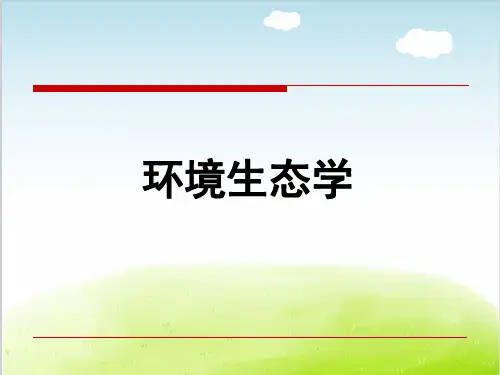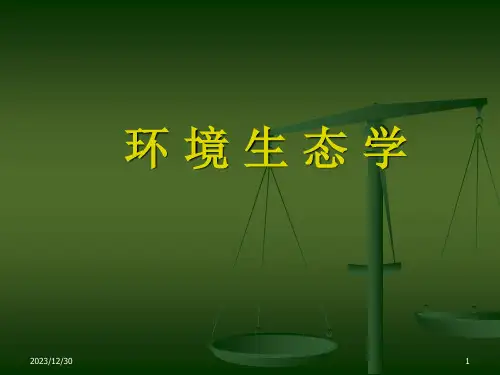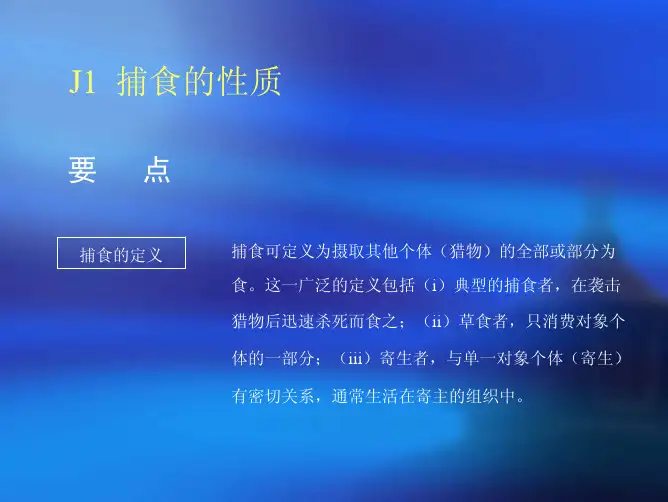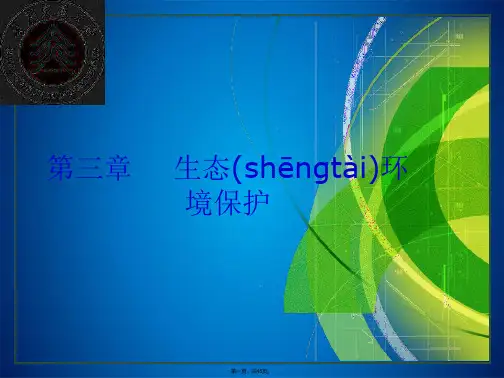【环境课件】生态学(双语)【珍藏版】
- 格式:doc
- 大小:35.50 KB
- 文档页数:7











环境生态学(外文资料及翻译)"Environmental ecology, mainly in humanities and social and environmental ecology international wide public concern" the concept of sustainable development ", "environmental protection and sustainable development strategy problem", "harmonious society and circular economy", "human survival way and environmental ecological crisis", "China at the beginning of 21 century on the path of sustainable development", "environmental culture and living safety", "global warming the earth's environment and the ecological security", "ozone depletion of earth environment the ecological influence", "acid rain on the earth's environment the ecological influence", "urbanization on city environment and regional climate effect", "desert-oasis ecosystem water heat transfer and the interaction numerical simulation", "western China development of water resources and the sustainable development problems".In the 21 st century, the human face of worsening ecological environment and the lack of human resources, clearly recognized that must walk the path of sustainable development. From a long-term perspective, the development environment ecological education is to solve the environmental problems and the implementation of the strategy of sustainable development at all. Higher school education is to improve theecological environment of the new century, the environment of the builders ecological awareness, to the transportation environment of specialized personnel the ecological protection of important way. As a contemporary college students, must have the living environment and the sense of urgency and have the time should be the new century demand quality talent environmental knowledge.Green peace in China and international stage play an active role. In China, the green peace was China's most influential media as "China's best public organization"; On the international stage, green peace at the UN conference on climate change, and in the light of the international society should how to deal with climate change challenge from China put forward the folk organization views.Because of "traditional environmental technology can not to" contemporary environmental biological technology, the development of high level technology mainly in the hot, namely to molecular biology technology as the main body, by genetic engineering as the leading pollution diagnosis, pollution monitoring, pollution control and ecological remediation technologies. Among them, the environmental biological new technology, new methods of development and utilization, such as pollution of the environment molecular diagnosis technology ispollution control and repair the premise and basis. Because the current environmental biological technology researchers, still can't very well in biological chip, genetically modified, stem cell, protein group, metabolic group, biological technology, such as the development of light pollution detection and monitoring of the effective method.People and the environment is inseparable relationship. In the past, present and future, human beings are always in constant change the environment, create not only use, and beautiful environment space. City imply, is more than just building, streets, shops and construct the accumulation of artificial things and contain in many functional facilities and hard landscape of social culture, accompanied by economic, political and urban residents colorful life. From external visual image of the city is to see, by its plane structure, the sky outline, various building, facilities, regional market, open space, landmark plant gardens and indefinite traffic tools through a city, but these are people in choice and the selected behavior formed under the physical form, which contain deep natural law, social psychology, human emotions and historical vicissitudes of life.Urbanization in bring about many benefits for people at the same time, also caused a series of serious ecological environment problems, to natural ecosystem and the people's health effects. These problems isreflected in three aspects: one is the urban climate change (such as heat island effect) and environmental pollution, including water, air and noise and solid waste pollution, etc.; 2 it is natural resource depletion and shortages, especially fresh water, fossil fuel, cultivated land excessive utilization and biodiversity of the reduced; Three is the city the increase of population, resulting in a large number of social issues, such as housing nervous, heavy traffic, reduce, education and health and green lag and so on. Ecological city is to point to in ecological system, within the scope of carrying capacity of the ecological economy principle and system engineering construction method of the city. And Ecological city construction, change the traditional way of production and consumption, decision-making and management methods, fully mining district inside and outside the resources can be exploited to all potential, has developed economy, ecology and efficient industry, the system is reasonable, the harmony of the society culture and ecological health, landscape suitable environment, to achieve the conditions of the socialist market economy, economic growth and environmental protection, material civilization and the spiritual civilization, natural ecological and human ecological high unification.Ecological city practice methods should be coordinated economic and social development, at the same time ensure long-term ecological healthand future generations, the resources needed for survival and development. China's ecological city planning with other plan to have two different. Its planning time more than 20 years of general (general layout planning of fixed number of year), for long-term development direction. In addition, ecological city planning than any other plan covers the content more widely. China's ecological city method can reflect the most need to solve two aspects of the--the economic and ecological, the purpose is to seek for the economic and social benefits, long-term ecological health and resource management and coordination. Social issue would be in the discussions of the ecological city becomes more and more important. First, pay attention to the exploration of the urban ecology theory, especially the different scale of urban construction and function of; Second, expanding the scope of the city scientific research, that is, from the city by a single objective of the study, change is compound ecological system in rural and urban studies, including half of urbanized area research and rural industrialization and urban agglomeration research; Third, the development of ecological city construction applicable technology system, and promote the existing technology the ecological; Fourth, for ecological city construction ecological landscape planning and provide the ecological culture methodological guidance; Fifth, establish the corresponding policies and decrees and rewards and punishment system, promote the development ofecological city; Sixth, strengthen education, training and ecological city construction, enhance the ability of ecological consciousness; Seventh, to strengthen international between cities and communities, cooperation and communication between the.."We have a responsibility, which is not only consider the meaning, and open our own to experience the beauty and follows the lead. The urban environment art, a kind of choice and the progress of relief.The current both large and medium cities or towns and villages, the ecological construction practice in our country on booming has. People are more and more aware of ecological city development and construction of ecological city the importance and the urgency ofEcological city is put forward based on the awakening of the human ecological civilization and to the traditional industrialization and industrial cities, ecological city has not reflect pure natural ecology, but the natural, social and economic compound the symbiosis between the urban ecological, it and sanitation city, garden city, urban landscape, garden city, forest city, different qu co-workers, have distinction to have connection again already, have increase public cultural quality and life quality effect, note that the Chinese ecological environment conditionsdiffer in thousands ways, may not single development type and development model, need to adjust measures to local conditions of ecological city planning create all sorts of type and various development model.Facing the new century, the human orientation and inevitable choice is ecology. Urban ecological development path, construction go ecological city is the inevitable trend of the development of history. The construction of ecological city cannot leave the creative planning and design, creative planning and design need forward-looking theoretical guidance. In the research of ecological city became a city plan the forefront of research topic. Change the traditional urban planning values, it is necessary in new ecological values of the current under the guidance of the urban planning theory to a fundamental reform system, ecological city planning and design theory principle and method, the method, a series of problems, such as technology to meet the need of the time.Ecological city idea contains the sustainable development idea and city and nature coexist aims, the domestic future urban planning work have important significance. In today's science and technology is developed, to transform nature (namely human intervention natural ability of past situation, far beyond human must be aware that any living environment(including city) is a global ecological system, part of the human activities within the limit in the ecological necessary, and fully embodied in the planning, this is true in the premise of sustainable development of establishing ecological city, is also the fundamental guarantee.Ecological civilization of moral evaluation standard, in general, that is beneficial to the human and the nature harmonious relationship between the behavior of the construction is good, what things are harmful to the human and the nature harmonious relationship between the behavior of the construction is evil. Of course, consciously abide by the environmental law shall ecological civilization is the base line of ethics standards, specific provision people in dealing with the relationship between man and nature, what should do and what should not do. And active practice ecological ethics behavior may allow have DuoZhong realm. The highest state is "ecological self-supervision", that is, no matter when and where, regardless of whether supervision, always to ecological moral standard, in the interests of both consciously and ecological benefits, the determination to promote the harmony between human being and nature and prosperity, and the relationship between man and nature to solve the crisis with all my heart. In short, ecology theory in China construction of ecological civilization society has the important, not the role of the body, and provide scientific theory.Hope that nature can peace and common forever!!!!!《环境生态学》主要以人文社会和环境生态学方面国际社会广泛关注的“可持续发展的理念”、“环境保护与可持续发展战略问题”、“和谐社会和循环型经济”、“人类生存方式与环境生态危机”、“中国21世纪初可持续发展之路”、“环境文化与生存安全”、“全球变暖与地球环境生态安全”、“臭氧层破坏对地球环境生态的影响”、“酸雨对地球环境生态的影响”、“城市化对城市环境及区域气候的影响”、“沙漠-绿洲生态系统水热输送及相互作用数值模拟”、“中国西部水资源开发与可持续发展问题”。
环境课件生态学双语 A1 什么是生态学要点 A1 WHAT IS ECOLOGY A2 生态学的10个规律要点 A2 TEN RULES IN ECOLOGY B1 适应要点 B2 应付环境变异要点 B3 生态位要点 C1 太阳辐射与气候要点C2 微气候要点 D1 水的特性要点 D2 植物与水要点 D3 动物与水要点 E1 温度与代谢要点 E2 对温度的响应要点 E3 温度与物种分布要点 F1 太阳辐射与植物要点 G1 资源与循环要点 G2 植物与消费者要点 G3 土壤形成特性和分类要点 H1 种群和种群结构要点 H2 出生率死亡率和种群增长要点 H3 密度和密度制约要点 H4 种群动态波动周期和混沌要点I1 竞争的性质要点 I2 种内竞争要点 I3 资源分配要点 J1 捕食的性质要点 J2 捕食行为和猎物反应要点 K1 寄生的性质要点 K2 寄生的动态要点 L1 互利共生要点 M1 生活史要点 N1 社群合作和利他行为要点 N2 生态学中的性要点 O1 遗传的变异要点O2 物种形成要点 P1 组成成员和过程要点 P2 初级和次级生产力要点P3 食物链要点 Q1 群落结构和稳定性要点 Q2 岛屿群落与移殖要点 Q3 群落格局竞争和捕食要点 R1 演替要点 R2 群落对干扰的反应要点 S1 生态系统格局要点 S2 草地要点 S3 冻原要点 S4 森林要点 S5 荒漠半荒漠和灌丛要点 S6 盐水生物群系要点 S7 淡水生物群系要点 T1 收获理论要点 T2 渔业和捕鲸业要点 U1 有害生物问题及其防治对策要点 U2 杀虫剂和问题要点 U3 生物防治和害虫综合治理要点 V1 稀有物种生境损失和灭绝要点 V2 保育对策要点 V3 生物资源和基因库要点 W1 空气水和土壤污染物要点 W2 温室气体和全球变暖要点 W3 臭氧要点 X1 土壤侵蚀和农业要点 X2 养分水和能量利用要点 Related topics Fishing and whaling T2 The open ocean is used as a dumping ground for numerous pollutants including oil sewage hydrocarbons and metals Some become magnified in the food web and can contaminate fish stocks Recreational and commercial development of intertidal regions has led to habitat destruction and pollution Dredging sewage pollution and over-fishing have degraded coral reefs Environmental concerns 主要的淡水和湿地区域淡水生物群系包括湖泊河流酸性沼泽草本沼泽和木本沼泽这些系统靠从附近排水区沥滤的水和营养物生存Freshwater biomes include lakes rivers bogs marshes and swamps These systems are fed by water and nutrients leaching from the surrounding catchment area Key Notes Primary freshwater and wetland regions S7 FRESHWATER BIOMES 溪流和河流溪流和河流的物理特征沿水体长度而有变化它们靠近源头的窄小湍急变成河口附近的宽广平缓植物和动物的多样性和生产量在中部地区通常是最高的因为那儿的水流速度和河床底质允许大型植物的生长湖泊和池塘湖泊的水很少流动或者不流动使得水体可垂直分层包括表层光照充足而温暖的水和下层黑暗而寒冷的水湖泊可以是营养充足的富营养型或者是营养匮乏的贫营养型 The physical characteristics of streams and rivers alter along their length they change from being small and turbulent close to their source to wider and slower at their mouth Plant and animal diversity and production tends to be highest in the middle regions where flow rates and substrate allow the growth of macrophytes Streams and rivers Lakes have very little or no current allowing the water body to acquire vertical stratification with illuminated warm water at the surface and dark cold water below Lakes can be nutrient rich eutrophic or nutrient poor oligotrophic Lakes and ponds 环境关系开凿运河商业开发和污染造成了许多河流下游水生生物和河岸植被的减少湿地被用于农业变成了农田和牧场富营养化由生物或非生物的污染而造成结果导致植物多样性的减少和藻类的大量生长这个问题在小湖泊小池塘以及半封闭系统如英国的Norfolk 宽阔河段中尤其显著相关主题空气水和土壤污染物W1 Related topics Air water and soil pollutants S7 Canalization commercial development and pollution have resulted in a loss of aquatic biota and bankside vegetation in the lower reachesof many rivers Wetlands have been lost to agriculture for grain production and grazing Eutrophication can occur through organic and inorganic pollution resulting in a loss of plant diversity and algal blooms This is a particular problem in small lakes and ponds and in semiclosed systems such as the Norfolk Broads Environmental concerns 收获目标为了使种群开发获得最大回报管理应以使对象种群可长期持续获得最大产量为目标 To maximize the returns gained by exploiting a population management should aim to harvest the maximum yield that the maximum yield that the population can produce sustainably over the long term Key Notes The goals of harvesting T1 HARVESTING THEORY 最大持续产量长期收获最大产量的一种方法是最大持续产量即MSY法随着种群密度在很低的基础上开始增加出生率超过死亡率种群的净补充量增加当种群密度达到最大环境容纳量时死亡率上升出生率下降因此最大净补充量发生在中等密度种群中存在许多繁殖个体而种内竞争又相对较弱的情况下这一最大净补充量即为人们可长期从种群中收获的最大量MSY One approach to deduce the maximum long-term yield is known as the maximum sustainable yield or MSY approach As a population increases in density from very low numbers the birth rate outstrips the death rate so the net recruitment births-deaths into the population rises As the population density approaches the maximum the environmentcan support the death rate increases and the birth rate falls The maximum net recruitment therefore occurs at an intermediate density when intraspecific competition is relatively low yet there are many reproductive individuals in the population This maximum net recruitment is the maximum number that can be harvested from the population sustainably – the MSY Maximum sustainable yield 配额限制在一定时期可通过控制配额收获对象生物量或个体数量限制收获配额控制允许收获者在每一<a name=baidusnap0></a>季节</B>或每年收走一定数量的猎物配额限制通常应用于海洋渔业来获得MSY但成功例不多这表明配额限制实际上很冒险有可能导致过捕甚至种群灭绝Harvesting may be limited by controlling the quota the biomass or number of individuals culled in a given period Quota controls thus allow the harvesters to remove a fixed number of the prey species every season or year Quota limi-tataion is commonly applied in marine fisheries to achieve a MSY with limited success The theory demonstrates that quota-limitation is intrinsically risky and may cause overexploitation and even extinction of the harvested populations Quota limitation 努力限制配额限制潜在的危险或通过导入努力限制来缓和努力限制具有明显的优点因为当猎物种群数量减少时人们往往会通过更加努力来获限正在减少中的数量环境波动利用种群增长模型预测被收获种群可获潜能的效果会受到环境波动的严重影响因为环境波动会影响种群的出生率或死亡率 The ability of models of population growth to predict the harvesting potential of a population is esverely compromised by environmental variation which may affect recruitment or mortality Environmental fluctuation The risk inherent in quota-limitation can be alleviated by adopting an approach of limiting effort This has a clear advantage- as a prey species becomes rarer more effort will be required to seek out and catch the diminishing numbers Effort limitation 相关主题种群和种群结构H1 密度和密度制约H3出生率死亡率和种群增长H2 种群动态波动周期和混沌H4 动态库模型简单的模型不考虑种群的年龄结构这使其预测能力有限因为死亡率与繁殖力都是与年龄相关的收获个体通常都是种群中体大年高的个休具有最高的繁殖潜能精确地考虑到不同年龄群出生率生长和死亡率的动态库模型对对象种群的预测效果更好举例来说考虑到不同年龄群的动态库模型意味着可理论上检测海洋渔业中使用不同大小网具的影响效果 Simple models do not consider the age structure of populations which limits their predictive power as the mortality rates and reproductive output of individuals is age-specific Usually the individuals harvested are the larger and older members of the population which have the highest reproductive potential Dynamic poolmodels explicitly consider the recruitment growth andmortality of different age classes allowing a better model ofthe population to be derived This approach means that forexample the impact of varying mesh size in a marine fishery canbe tested theoretically Dynamic pool models Related topicsPopulations and population Density anddensity structure H1 dependence H3 Natality mortality and Populationdynamics –fluctuations growth H2 cycles and chaos H4 渔业海洋一直为我们人类提供丰富的食物资源现在全球渔获量约1亿吨其中一小部分并不直接被人类消费而是用做动物饲料大洋生产力与陆地系统相比大洋是生产力很低的生境大陆架生产力较高但全球单位公顷渔获量很低部分是因为大洋区极低的生产力部分是由于渔获物处于食物链高营养级其生产效率很低 The arctic。